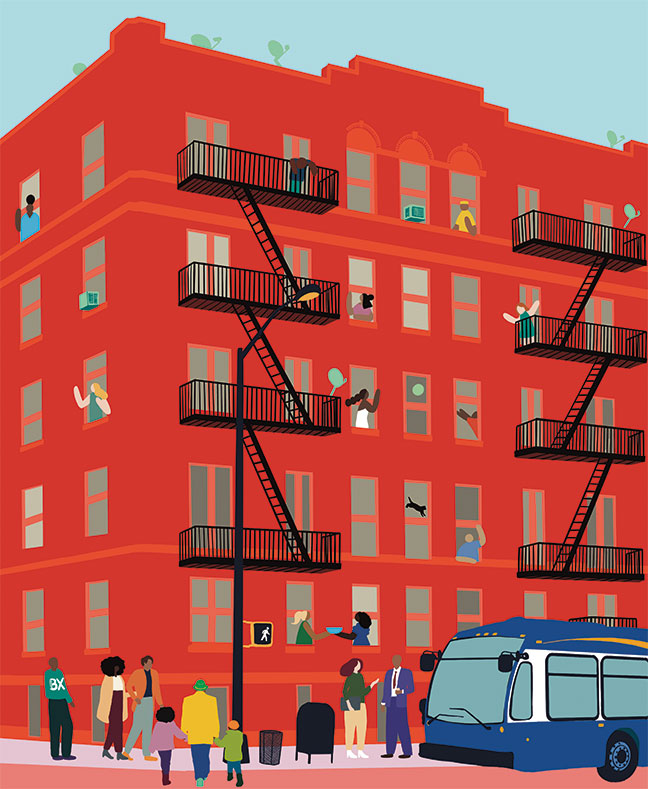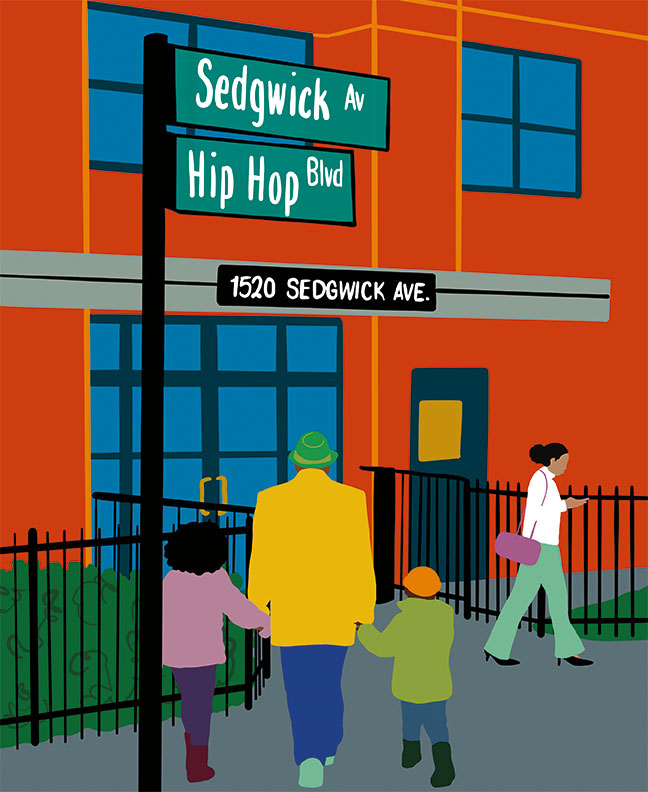Get involved now with these four service outings happening in January and February.
1. Help Provide School Supplies for Neighborhood Children
Monday, January 27, 2 p.m. to 3 p.m.
Lowenstein Center, Room 1004
Join your fellow Rams on the Lincoln Center campus to wrap school supply care packages for neighborhood children. Participants can also include personal notes of affirmation.
2. Create Food Packages for Senior Citizens in Need
Saturday, January 25, 9 a.m. to 11 a.m.
239 West 49th Street
Fordham’s commitment to the Broadway community goes beyond excellence onstage and behind the scenes. This month, the University is joining Encore Community Services—a Catholic Charity partner just a short subway ride from the Lincoln Center campus—to create food parcels that will support neighborhood seniors in need, many of whom worked in the performing arts. Since 1977, Encore has provided seniors with a range of services to help them live independent and dignified lives in the midtown Times Square and Clinton communities. For this reason, and its focus on initiatives such as “aging gracefully through the arts,” Encore has earned a reputation as “Broadway’s Longest Running Act of Loving Care.”
This event is sponsored by the Office of Alumni Relations, as part of its For and With Others Volunteer Day, but it’s open to the entire University community.
3. Fight Food Insecurity in the Bronx
Friday, January 31, 1:30 p.m. to 3:30 p.m.
St. Ignatius Middle School
Wednesday, February 12, 11:30 a.m. to 12:45 p.m.
McShane Campus Center Entrance
Among the issues affecting New Yorkers daily, food insecurity is one of the most pressing. According to the New York State Department of Health, about one in four New Yorkers report that they do not have sufficient access to food.
Two upcoming events give the Fordham community an opportunity to promote food security in its own backyard. Students and other volunteers will gather to make up to 200 meal packs for community fridges, and conclude the day with a brief Ignatian reflection. The first of these events will happen alongside students at St. Ignatius Middle School in the Bronx. The second will take place at the McShane Campus Center.
Both events are offered through Fordham’s Department of Mission Integration and Ministry, which is rooted in the Jesuit tradition of balancing reflection and action, a practice developed by St. Ignatius Loyola, the 16th-century founder of the Jesuits.
4. Connect with Those Experiencing Houselessness
Sunday, February 23, 11:30 a.m. to 4 p.m.
Meet in the Lowenstein Center Lobby
Volunteers will join forces with students enrolled in the Philosophical Ethics course at the Lincoln Center campus and visit Xavier Mission, a nonprofit organization in Manhattan’s Chelsea neighborhood. Together they will share in conversation and serve a hot meal to people experiencing houselessness in New York City. Attendees will take the brief subway trip together, with MetroCards provided.
This experience is presented by Fordham’s Center for Community Engaged Learning, which connects Fordham with dozens of local and global partners to provide students with opportunities for experiential learning, research, and civic engagement.
]]>The fund dovetails with one of the key priorities of Fordham’s recent fundraising campaign, Cura Personalis | For Every Fordham Student, with its emphasis on equity and inclusion as well as the wellness of every student. Here are five examples of the numerous activities it has made possible:
No. 1: Ignatian Q.
With support from the fund, 10 Fordham students traveled to St. Louis University in April for this annual conference organized by the Association of Jesuit Colleges and Universities to promote community and spirituality among LGBTQ students. (Fordham hosted Ignatian Q in 2023 with support from the wellbeing fund.) In the words of one Fordham graduate student who attended, Tatum Allen, FCLC ’24, “it offered me a space to feel less alone as a queer person of faith.”
No. 2: Students Together for Acceptance, Respect, and Support (STARS).
Piloted last year by professors and students in the psychology department and the Graduate School of Social Service, this network brings Fordham students together with local high school students seeking to engage with LGBTQ peers, find support, and build community. Two of the high schoolers also took part in a year-long research project on LGBTQ experiences in school and presented their research at the Eastern Psychological Association Conference in Philadelphia.
No. 3: Oral History Project with SAGE Center Bronx.
Last year, undergraduate students in a communications class—titled Photography, Identity, Power—worked with residents of the SAGE center, a community center for LGBTQ seniors, to produce a digital exhibition of their photography that includes an oral history element. Students in an art class, Visual Justice, later met with the seniors and made portrait photographs of them.
No. 4: Queer Prayer Book.
The book Queer Prayer at Fordham was developed in 2023 and distributed at Ignatian Q when it was held at the University.
No. 5: NYC Interfaith Pilgrimage/Retreat
This daylong retreat at the Lincoln Center campus, held in February, centered on art as a way to explore the intersection between spirituality and queerness. About two dozen students and alumni gathered for morning presentations, toured sites important to the LGBTQ community in Greenwich Village, and reconvened on campus to produce their own art.
No. 6: Urban Plunge and Global Outreach Scholarships.
With support from the wellbeing fund, LGBTQ students received scholarships to take part in Urban Plunge and Global Outreach, two programs of the Center for Community Engaged Learning.
Sources: Fordham Campus Ministry, Center for Community Engaged Learning
]]>Answering a call from Pope Francis, Fordham is indeed a place committed to taking “concrete actions in the care of our common home.”
Here are some updates from the first quarter of 2024, from student sustainability interns to “cool” foods to fun community events that make an impact.
Facilities
In January, 11 more undergraduate students joined Fordham’s Office of Facilities Management as sustainability interns to help the University in its efforts to reduce its carbon emissions. They’re working on projects connected to AI-enabled energy systems, non-tree-based substitutes for paper, and composting. The office is still looking for three more students to join; email Vincent Burke at [email protected] for more information.
Dining
Stroll into a dining facility at the Rose Hill or Lincoln Center campus, and you’ll find “Cool Food” dishes such as crispy chicken summer salad, California taco salad, and spicy shrimp and penne.
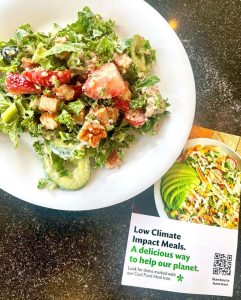
The dishes, which are marked by a distinctive green icon at the serving station, have a higher percentage of vegetables, legumes, and grains, which generally have a lower carbon footprint than those with beef, lamb, and dairy. According to the World Resources Institute—which Fordham partnered with on the Cool Food project—more than one-quarter of the world’s greenhouse emissions come from food production.
In March, the University went one step further by signing onto the New York City Mayor’s Office Plant-Powered Carbon Challenge. The pledge commits Fordham and Aramark to reduce our food-supply carbon emissions by a minimum of 25% by the year 2030.
Academics
This semester, a new one-credit, university-wide experiential learning seminar titled Common Home: Introduction to Sustainability and Environmental Justice was taught by faculty and staff from the Gabelli School, the Center for Community Engaged Learning, the Department of Facilities, the Department of Biology, and the Department of Theology.
Other sustainability-focused courses this semester include the City and Climate Change, the Physics of Climate Change, and You Are What You Eat: the Anthropology of Food (Arts and Sciences); Sustainable Reporting and Sustainable Fashion (Gabelli School of Business); and Energy Law and Climate Change Law and Policy (Law).
Did You Know?
Like most buildings in New York City, the ones on the Rose Hill campus get almost all of their power from power plants fueled by natural gas (along with some solar power). To power a building like Walsh Library, a natural gas-powered plant normally uses 37 million gallons of water annually. But fuel cells like the ones that were installed at the Walsh Library in 2019 actually make their own water, and as as result, Fordham is saving the community the equivalent of 57 Olympic-sized pools each year.
Students Take the Lead
At Fordham Law School, the student-run Environmental Law Review hosted a March 14 symposium that considered the impact of artificial intelligence on environmental law. Panels focused on how regulators and litigators can use AI and the challenge of addressing AI-generated climate misinformation.
In January, Fordham Law student Rachel Arone wrote The EPA Rejected Stricter Regulations for Factory Farm Water Pollution: What This Means, Where Things Stand, and What You Can Do for the Environmental Law Review. And the Law School’s student-faculty-staff collective Climate Law Equity Sustainability Initiative held a series of lunchtime discussions about climate change, law, and policy.
Student groups LC Environmental Club and Fashion for Philanthropy teamed up on March 8 to create reusable tote bags on International Women’s Day. The bags were donated to Womankind, which works with survivors of domestic/sexual violence and trafficking.
The United Student Government Sustainability Committee continues to run the Fordham Flea, a student-run thrift shop that connects students interested in selling old clothes with those looking to buy sustainably. The next flea will take place on April 26 from 11 a.m. to 2 p.m. outside of the McShane Center.
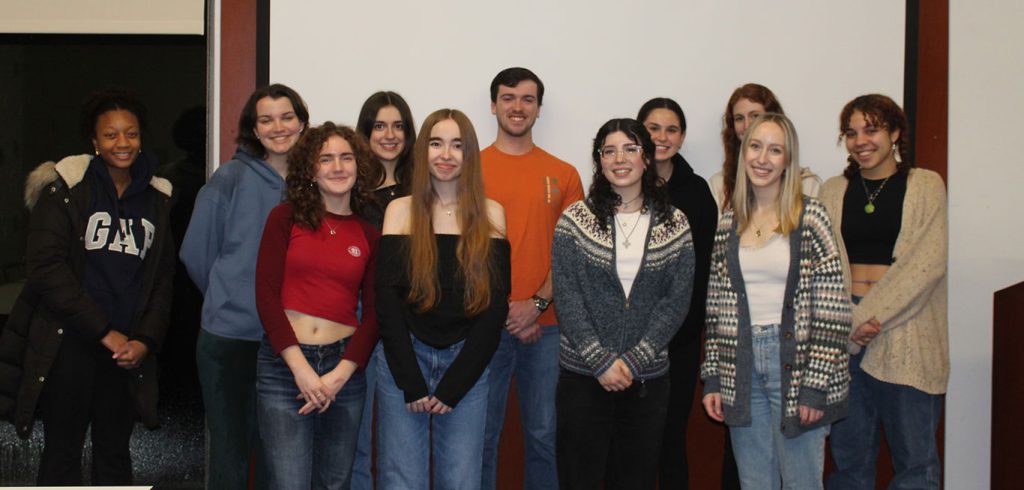
Community Engagement
The Center for Community Engaged Learning (CCEL) held an Urban Agriculture and Food Security Roundtable on Feb. 2. The gathering brought together community organizations and leaders from the Bronx to discuss urban agriculture and food security. Attended by Bronx Congressman Ritchie Torres, the meeting was also an opportunity for groups to learn about resources available from the USDA and the New York City Mayor’s Office on Urban Agriculture.
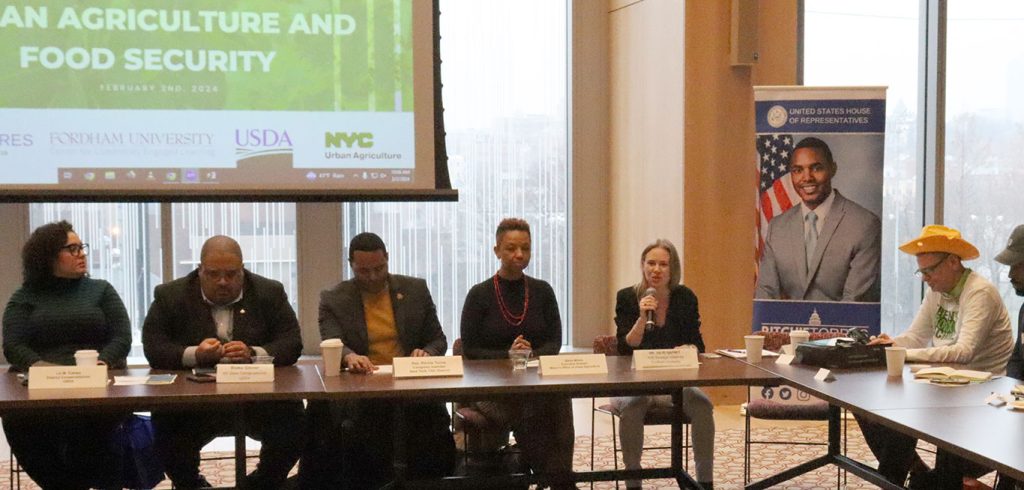
CCEL Director of Campus and Community Engagement Surey Miranda-Alarcon served as a panelist at a March 9 climate justice workshop at SOMOS 2024 in Albany, along with Mirtha Colon, GSS ’98, and Murad Awawdeh, PCS ’19.
Faculty News
David Gibson, director of the Center on Religion and Culture, and Julie Gafney, Ph.D., director of the Center for Community Engaged Learning, attended “Laudato Si’: Protecting Our Common Home, Building Our Common Church” conference at the University of San Diego on Feb. 22 and 23.
Marc Conte, Ph.D., professor of economics, and Steve Holler, Ph.D., associate professor of physics, presented their research around air quality, STEM education, and education outcomes on March 11 at the first night of Bronx Appreciation Week, which the Fordham Diversity Action Coalition organized.
Alumni
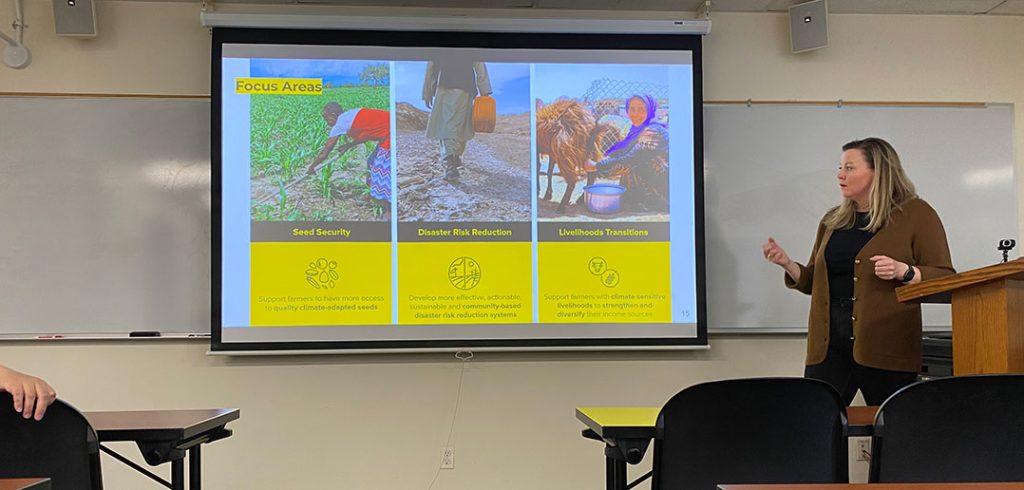
On March 14, Tara Clerkin, GSAS ’13, director of climate research and innovation at the International Rescue Committee, delivered a lecture at the Rose Hill campus titled “The Epicenter of Crisis: Climate and Conflict Driving Humanitarian Need and Displacement.”
In Case You Missed It
Here are some sustainability-related stories that you may have missed: In January, economics professor Marc Conte published the findings of a study that examined whether people living in areas with more air pollution suffer more from the coronavirus. The Gabelli School of Business partnered with Net Impact, a nonprofit organization for students and professionals interested in using business skills in support of social and environmental causes. A group of the Gabelli School Ignite Scholars traveled to the Carolina Textile District in Morgantown, North Carolina, to learn the benefits of sustainable and ethical manufacturing.
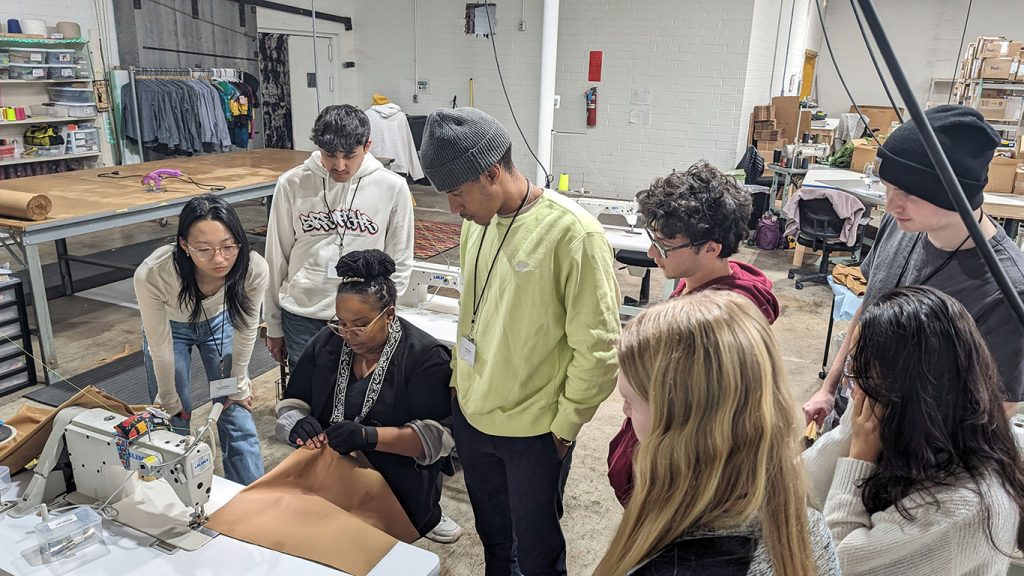
Upcoming Events
April 12 and 19
Poe Park Clean-up
In celebration of Earth Day on April 22, the Center for Community Engaged Learning is organizing visits to the park, where volunteers can help pull weeds and spread mulch. 10 a.m. – 2 p.m., 2640 Grand Concourse, the Bronx. Sign up here.
April 13
Bird Watching in Central Park
Law professor Howard Erichson will lead students on a birdwatching tour of Central Park, where they hope to spot and identify a few of the hundreds of species that pass through Fordham’s backyard on their annual migration routes. Meet at the Law School lobby at 9:30 a.m. Contact [email protected] to reserve a spot.
April 13
Ignatian Day of Service
Students and alumni will meet at the Lincoln Center campus and walk over to nearby Harborview Terrace, where they will build a community garden with residents. Lunch and a conversation about Ignatian leadership will follow. 10 a.m. – 2 p.m.
Click here to RSVP.
April 15
ASHRAE NY Climate Crisis Meeting
The theme of this meeting of the American Society of Heating, Refrigerating, and Air-Conditioning Engineers is “Challenge Accepted: Tackling the Climate Crisis.” All are welcome.
7 a.m.- 1 p.m., Lincoln Center Campus. Contact Nelida LaBate at [email protected] for more information or register here using code FordhamStudent2024.
We’d Love to Hear From You!
Do you have a sustainability-related event, development, or news item you’d like to share? Contact Patrick Verel at [email protected].
]]>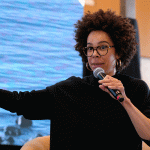
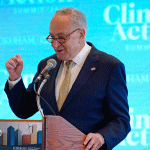
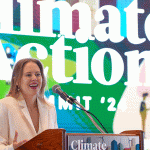
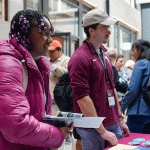
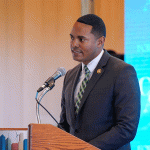
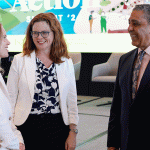
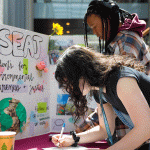
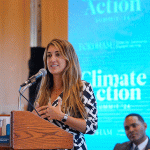
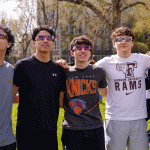
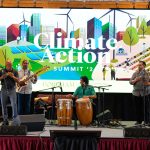
Daylong Event Calls for Grassroots Action and Celebrates Fordham’s Role as EPA Grantmaker
We don’t all have to be scientists to fight climate change, a prominent marine biologist and activist told Fordham students, activists, and members of the Bronx community at Fordham’s Rose Hill campus on April 8.
“I think what the world needs, right now more than ever, are people who can move between different disciplines,” said Ayana Elizabeth Johnson, Ph.D.
“We need people to solve climate problems in business, in engineering, in law, in medicine … all of these things relate to the world and how it’s changing. Everyone needs to know at some fundamental level what’s happening.”
Johnson, a marine biologist and co-founder of the group Urban Ocean Lab, was the keynote speaker of Fordham’s second annual Climate Action Summit. Her speech, on a day when millions of Americans paused to take in a rare solar eclipse, was a reflection of her personal journey and activism taken from her forthcoming book, What If We Get It Right? (Penguin Random House). She also sat for a Q&A session with H. Shellae Versey, Ph.D., an associate professor of psychology at Fordham.
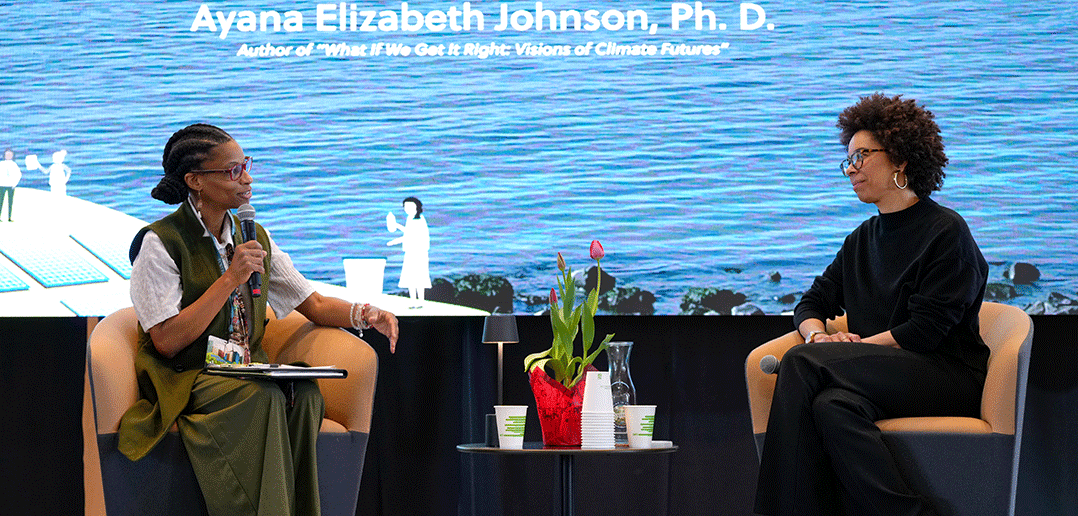
The work she’s done on behalf of communities from New York City to the Caribbean, she said, was always bolstered by a belief that anyone can be a part of the fight–including those who, like her father, were held back by racism, or those like her, “brimming with juxtapositions.”
“I’m a scientist who always intended to have a career in policy. I’m the daughter of a practical school teacher and a wistful artist. I’m cold New York winters and Caribbean heat,” she said.
“I’m working class and Harvard. I’m Black and white. I’m urban and smitten with the wilderness. I’m proof of the American dream—and proof that it is all too rare.”
The notion of taking a leadership role in fighting climate change was also the focus of other activities during the summit, which was organized by Fordham’s Center for Community Engaged Learning. An expo featured community groups, fireside chats, and panel discussions that examined federal funding for community-led solutions, as well as the future of environmental justice in higher education.
Elected Officials Celebrate Fordham’s Role as EPA Grantmaker
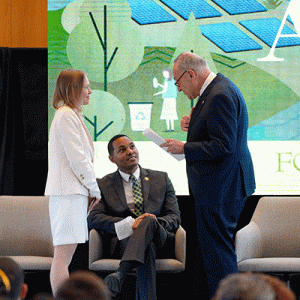
A morning press conference featured Senate Majority Leader Chuck Schumer and Congressman Ritchie Torres, who praised Fordham for taking on the responsibility of distributing $40 million EPA funds through a grant it was awarded in December. The grant, which will be administered by the Center for Community Engaged Learning, was the direct result of the Inflation Reduction Act (IRA), which was passed in 2022.
No Better Place
“We couldn’t have thought of a better place than Fordham to dispense this [funding]to go to grassroots groups,” said Schumer, who was instrumental in passing the IRA.
Torres added the program is benefiting the Bronx not by accident, but by design. “We designed the Inflation Reduction Act to lift up the lowest-income communities of color, especially the Bronx, which has been Ground Zero for environmental injustice,” he said.
The Bronx Is Not Burning; the Bronx Is Greening
“For a Bronx-based institution to receive $50 million in federal funding to distribute throughout the region is nothing short of staggering and unprecedented. And so, with the partnership of Fordham University, we are writing a new chapter in the story of the Bronx. The Bronx is not burning; the Bronx is greening.”
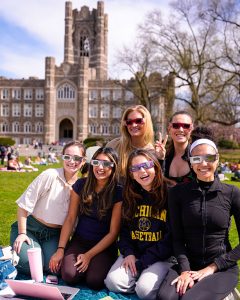
Also attending the celebration was U.S. Rep. Adriano Espaillat. Others who could not attend sent staff members, including Gov. Kathy Hochul, Sen. Kirsten Gillibrand, U.S. Rep. Paul Tonko, Bronx Borough President Vanessa Gibson, City Council Member Oswald Feliz, Westchester County Executive George Latimer, and Ulster County Executive Jen Metzger. See more elected official comments here.
Tania Tetlow, president of Fordham, said the grant, which will see the Center for Community Engaged Learning working with partner organizations from New York to Puerto Rico, epitomizes the mission of Fordham.
“This is so very us, this idea of connecting science with justice, of thinking about how we wake people up to the dangers ahead, and the chances to work together and inspire action and bring hope to an issue that can make us all despair and want to look away,” she said.
Julie Gafney, Ph.D., assistant vice president for strategic mission and executive director of the Center for Community Engaged Learning, thanked those responsible for the funding, community partners, and all those that will be involved in the project.
“Many of you are going to be partners in this work as we move ahead and really reorient Fordham around an initiative of public impact and social responsibility and see how traditional teaching, learning, and research can be leveraged in real-time toward community solutions.”
]]>Since the 1970s, Fordham students have been studying and contributing to the spirit of innovation and community renewal that has come to define what it means to be a Bronxite.
Fifty years ago, a new art form burst forth on the streets of the Bronx, born from rich musical traditions and a spirit of innovation in neighborhoods of color ravaged by deindustrialization and written off by most of the country. In the ensuing decades, the Fordham community has not only studied and celebrated hip-hop as a revolutionary cultural force but also helped preserve its Bronx legacy—through efforts to recognize the apartment building at 1520 Sedgwick Avenue as the genre’s birthplace, and through oral-history interviews with some of hip-hop’s seminal figures.
“I think the lesson is, let’s explore, interrogate, and embrace the cultural creativity of our surrounding areas because it’s unparalleled,” said Mark Naison, Ph.D., professor of African and African American studies and founding director of Fordham’s Bronx African American History Project.
Naison teaches a popular class, From Rock and Roll to Hip-Hop, that draws on artists like Cardi B, Nas, and Run-DMC to understand the music and its part in U.S. history—and to explore issues he’s spent his career teaching. “I’m not a hip-hop scholar,” he said. “Rather, I’m someone who works to have community voices heard.”
And just as the music has evolved over the past 50 years, so have efforts to revitalize the borough and tell the stories of its residents.
Challenging ‘Deeply Entrenched Stereotypes’
Amplifying community voices is at the heart of the Bronx African American History Project (BAAHP). Fordham launched the project in 2002, at the request of the Bronx County Historical Society, to document and preserve the history of Black people in New York City’s northernmost borough. Naison and his team of Fordham students, faculty, and community historians have spoken with hip-hop pioneers like Pete DJ Jones and Kurtis Blow, but the project is much broader: The archive contains verbatim transcripts of interviews with educators, politicians, social workers, businesspeople, clergy members, athletes, and leaders of community-based organizations who have lived and worked in the Bronx since the 1930s. The archive, which also includes scholarly essays about the Bronx, was digitized in 2015, making the interviews fully accessible to the public.
“Starting by interviewing a small number of people I already knew,” Naison wrote in Before the Fires: An Oral History of African American Life in the Bronx from the 1930s to the 1960s (Fordham University Press, 2016), “I stumbled upon a large, passionate, and knowledgeable group of people who had been waiting for years to tell stories of communities long forgotten, communities whose very history challenged deeply entrenched stereotypes about Black and Latino settlement of the Bronx.”
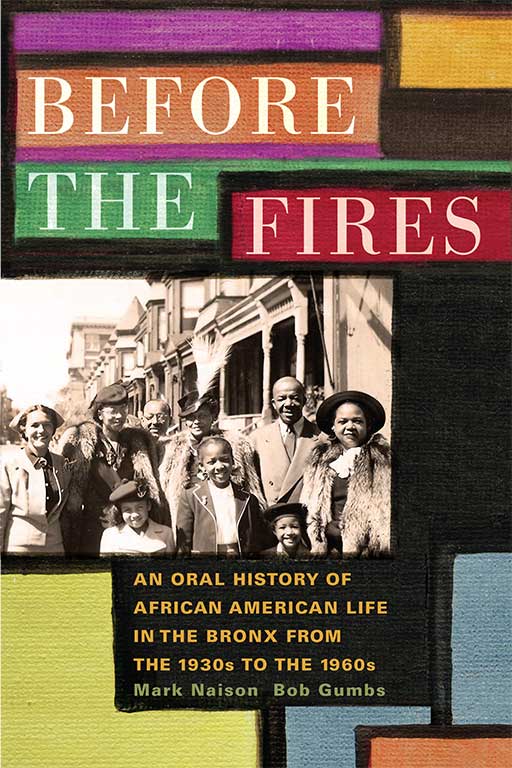 For Naison, the project highlights how the borough, defying the odds, rebuilt neighborhoods following the arson of the 1970s and the crack epidemic of the 1980s. The neighborhoods, with lower crime rates, saw community life flourish again, and in recent decades, the Bronx became a location of choice for new immigrants to New York. BAAHP research includes interviews with Bronxites from Ghana, Nigeria, Mali, Sierra Leone, Guinea, and Burkina Faso, among other nations. It gives voice to growing, diverse immigrant communities that have enlivened Bronx neighborhoods where Jewish, Irish, Italian, Puerto Rican, and Dominican people lived before them. “The Bronx is this site where people mix their cultures and they create something new,” Naison said. “It makes this a lot of fun to study.”
For Naison, the project highlights how the borough, defying the odds, rebuilt neighborhoods following the arson of the 1970s and the crack epidemic of the 1980s. The neighborhoods, with lower crime rates, saw community life flourish again, and in recent decades, the Bronx became a location of choice for new immigrants to New York. BAAHP research includes interviews with Bronxites from Ghana, Nigeria, Mali, Sierra Leone, Guinea, and Burkina Faso, among other nations. It gives voice to growing, diverse immigrant communities that have enlivened Bronx neighborhoods where Jewish, Irish, Italian, Puerto Rican, and Dominican people lived before them. “The Bronx is this site where people mix their cultures and they create something new,” Naison said. “It makes this a lot of fun to study.”
Shaping Global Perceptions
Brian Purnell, Ph.D., FCRH ’00, helped facilitate at least 50 BAAHP interviews from 2004 to 2010, when he was the project’s research director. He said the archive is useful for anyone studying how cities have changed over the decades.
“I hope people use it to think differently about the Bronx, to include the Bronx more deeply and broadly in urban studies in the United States,” said Purnell, now an associate professor of Africana studies and history at Bowdoin College, where he uses the Fordham archive in his own research and in the classroom with his students. “I hope that it also expands how we think about Black people in New York City and in American cities in general from the mid-20th century onward.”
Since 2015, when the BAAHP archives were made available online, the digital recordings have been accessed by thousands of scholars around the world, from Nairobi to Singapore, Paris to Berlin. Peter Schultz Jørgensen, an urbanist and author in Denmark, has been using information from the digital archive to complete a book titled Our Bronx!
“Portraying and documenting everyday life in the Bronx, as it once was, is essential in protecting the people of the Bronx from misrepresentation, while at the same time providing valuable knowledge that can help shape their future,” he said. “Just as BAAHP gathers the web of memory, my book is about the struggles that people and community organizations have waged and are waging in the Bronx. And more important, and encouraging, it talks about how they are now scaling up via the Bronxwide Coalition and their Bronxwide plan for more economic and democratic control of the borough.”
Championing Bronx Renewal
The movement Jørgensen describes is one in which members of the Fordham community have long played key roles, according to historian and journalist Jill Jonnes, author of South Bronx Rising: The Rise, Fall, and Resurrection of an American City. In the mid-1980s, when she published the first edition of the book, Bronxites were just beginning to reverse the toxic effects of long-term disinvestment and arson that had ravaged the borough.
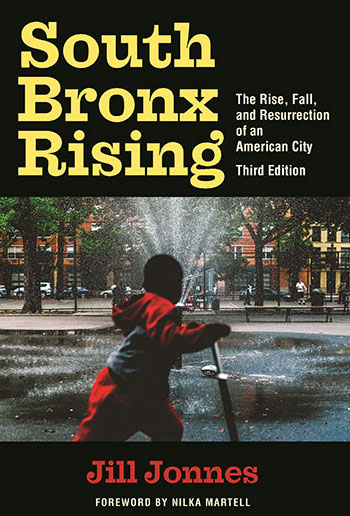 “Today, we far better understand the interplay of blatantly racist government policies and private business decisions … that played a decisive role in almost destroying these neighborhoods,” Jonnes wrote in a preface to the third edition of South Bronx Rising, published last year by Fordham University Press. “Even as fires relentlessly spread across the borough—as landlords extracted what they could from their properties regardless of the human cost—local activists and the social justice Catholics were mobilizing to challenge and upend a system that rewarded destruction rather than investment.”
“Today, we far better understand the interplay of blatantly racist government policies and private business decisions … that played a decisive role in almost destroying these neighborhoods,” Jonnes wrote in a preface to the third edition of South Bronx Rising, published last year by Fordham University Press. “Even as fires relentlessly spread across the borough—as landlords extracted what they could from their properties regardless of the human cost—local activists and the social justice Catholics were mobilizing to challenge and upend a system that rewarded destruction rather than investment.”
One of those Catholics was Paul Brant, S.J., a Jesuit scholastic (and later priest) who arrived at Fordham’s Rose Hill campus in the late 1960s to teach and to pursue graduate studies in philosophy. At the time, faith in the viability of cities was at a low point. Deindustrialization, suburbanization, and two decades of studied underinvestment had taken their predictable toll. The Bronx was experiencing the worst of it, and the people who lived in its neighborhoods were demonized as the cause of the problems.
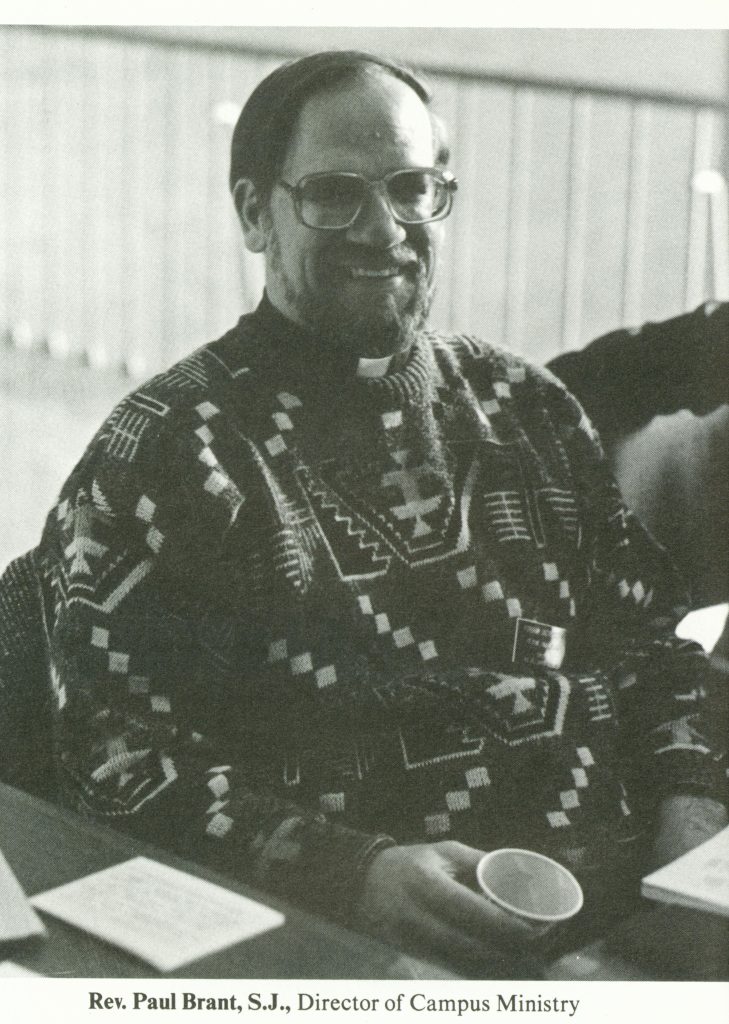
Brant, who died in May 2023 at the age of 82, wanted to understand what could be done. He earned a spot in New York City’s prestigious Urban Fellows program, meant to harness ideas for a city in crisis. Gregarious and forceful, yet able to work diplomatically, he had the backing of Fordham’s president at the time, James Finlay, S.J., to serve as the University’s liaison to the Bronx. With other young Jesuits, he lived in an apartment south of campus, on 187th Street and Marion Avenue, gaining firsthand insight into the scope of neglect and abandonment afflicting the borough.
“Paul felt, well, look, there’s a lot of people still in these neighborhoods. It’s not inevitable that everything gets worse,” said Roger Hayes, GSAS ’95, one of Brant’s former Jesuit seminary classmates. “What are we going to do?”
Long conversations with Hayes and Jim Mitchell, another seminary friend, convinced Brant that solutions to the Bronx’s problems would come by directing the power of the people themselves. In 1972, they formed a neighborhood association in nearby Morris Heights. They used relationships within the parish to confront negligent landlords. Seeing nascent successes there, they moved to launch a larger group.
In 1974, Brant convinced pastors from 10 Catholic parishes to sponsor an organization to fight for the community, and the Northwest Bronx Community and Clergy Coalition (NWBCC) was born. The group expanded to include Protestant and Jewish clergy—membership was always nonsectarian—and went on to train leaders in hundreds of tenant associations and neighborhood groups, including the University Neighborhood Housing Program, which Fordham helped to establish in the early 1980s to create, preserve, and improve affordable housing in the Bronx, and which has been led for many years by Fordham graduate Jim Buckley, FCRH ’76.
All of these groups were knit together across racial lines and around share interests during the worst years of abandonment and destruction. When they learned that rotten apartments had roots beyond individual slumlords, they picketed banks for redlining, the practice of withholding loans to people in neighborhoods considered a poor economic risk. Before long, Bronx homemakers and blue-collar workers were boarding buses to City Hall, demanding meetings with commissioners and testifying at the Federal Deposit Insurance Corporation.
With similar people-power organizations nationwide, they won changes in the nation’s banking laws through the Community Reinvestment Act of 1977, drove reinvestment to cities, and sprouted a new ecosystem of nonprofit affordable housing.
Preserving Hip-Hop’s Bronx Birthplace
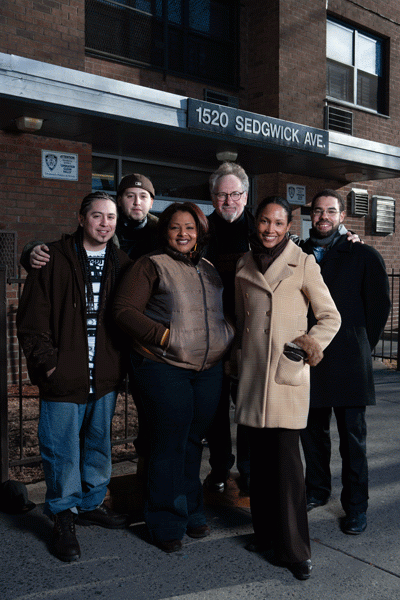
It’s the stuff of legend now: On August 11, 1973, Cindy Campbell threw a “Back to School Jam” in a recreation room at 1520 Sedgwick Avenue, a 100-plus-unit apartment building just blocks from the Cross Bronx Expressway in the Morris Heights neighborhood of the Bronx. Her brother, Kool Herc, DJ’d the party, which came to be considered the origin of hip-hop music.
Fast forward to 2008, when 1520 Sedgwick was laden with debt acquired by Wall Street investors who were failing to maintain the building. Organizers from the Urban Homesteading Assistance Board, a group focused on preserving affordable housing, hoped that documenting 1520’s history would help save it. They asked Fordham professor Mark Naison, Ph.D., to help. His research—which led to a lecture on C-SPAN and was highlighted in an August 2008 appearance on the PBS show History Detectives—helped convince the city government to intervene, eventually preserving the building as a decent and affordable place to live. In 2021, its standing became official: The U.S. Congress adopted a resolution acknowledging 1520 Sedgwick as the birthplace of hip-hop.
Learning About Bronx Renewal
Each year, Fordham’s Center for Community Engaged Learning shares this view of Bronx (and Fordham) history with incoming students, particularly those who participate in its Urban Plunge program in late August. The pre-orientation program gives new students the chance to explore the city’s neighborhoods and join local efforts to foster community development.
“For 30 years, the Plunge experience has offered our students their first introduction to institutions like Part of the Solution and the Northwest Bronx Community and Clergy Coalition, organizations founded by Fordham community members in collaboration with local residents that have built community, advocated for justice, and provided services and resources for the whole person,” said Julie Gafney, Ph.D., Fordham’s assistant vice president for strategic mission initiatives and executive director of the Center for Community Engaged Learning.
Students learn directly from local residents and policy experts about how they can shape policy decisions and build a better future for Fordham and its neighbors. “We really want to introduce first-year students, along with their upper-class mentors, to what’s driving community work in the Bronx right now,” Gafney said. “It’s an ideal ground for fostering a four-year commitment to community solution-building here in the Bronx.”
Reimagining the Cross Bronx
On August 25, nearly 250 first-year Fordham students fanned out across the Bronx as part of Urban Plunge. They served lunch to those in need at POTS—Part of the Solution, where Fordham graduate Jack Marth, FCRH ’86, is the director of programs; they helped refurbish Poe Park and the community-maintained Drew Gardens, adjacent to the Bronx River; and they visited the NWBCCC, now led by Fordham graduate Sandra Lobo, FCRH ’97, GSS ’04.
Students also learned about the Cross Bronx Expressway, a major highway built in the mid-20th century that has been blamed not only for separating Bronx communities but also for worsening air and noise pollution in the borough, contributing to residents’ high rates of asthma and other respiratory diseases.
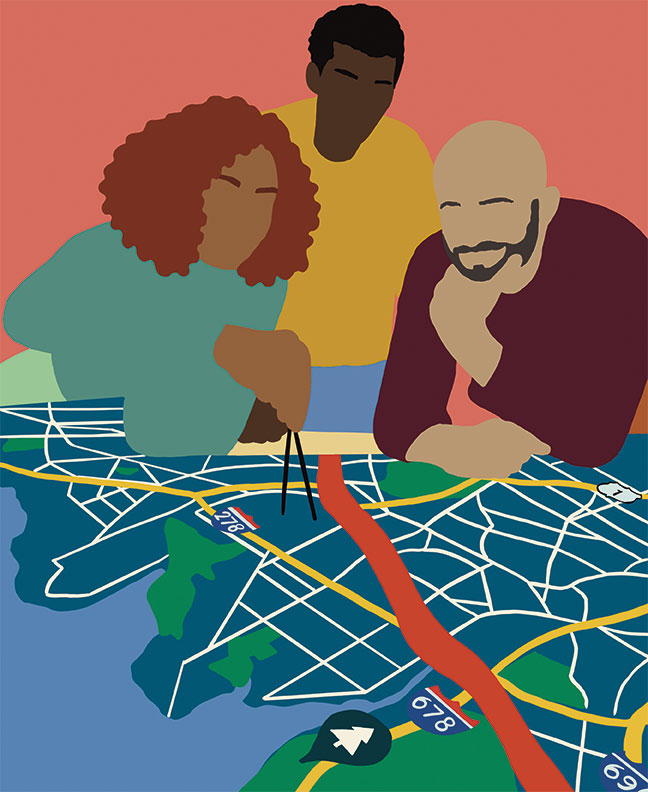 Before visiting parts of the expressway, students heard from Nilka Martell, founding director of Loving the Bronx, a nonprofit that has been leading community efforts to cap the Cross Bronx and develop public green spaces above and around it. A few years ago, Martell connected with Fordham graduate Alex Levine, FCRH ’14, who was pursuing the same goal.
Before visiting parts of the expressway, students heard from Nilka Martell, founding director of Loving the Bronx, a nonprofit that has been leading community efforts to cap the Cross Bronx and develop public green spaces above and around it. A few years ago, Martell connected with Fordham graduate Alex Levine, FCRH ’14, who was pursuing the same goal.
At Fordham, Levine majored in economics and Chinese studies and interned at the Department of City Planning in the Bronx. By 2020, he was a third-year medical student at Albert Einstein College of Medicine, where he co-founded the Bronx One Policy Group, a student advocacy organization focused on capping an approximately 2.5-mile section of the Cross Bronx that runs below street level. The idea is to cover the road with parks and install vents to remove toxic fumes caused by vehicular traffic. They said the cost of the project, estimated to be about $1 billion, would be offset by higher property values and lower health care costs.
“When you think of preventive medicine, it impacts everyone’s life,” Levine told the Bronx Times in 2021. “If we can get a small portion of this capped, then it might be a catalyst to happen on the rest of the highway. This is a project that can save money and lives.”
Martell said Levine’s group connected her with Dr. Peter Muennig, a professor at Columbia University’s Mailman School of Public Health who had published a study on the benefits of capping the Cross Bronx.
“We created this perfect trifecta,” she said. They brought their idea to Rep. Ritchie Torres, and in December 2022, the city received a $2 million grant from the U.S. Department of Transportation to study how to reimagine the Cross Bronx. Fordham’s Center for Community Engaged Learning later received a $25,000 grant from the New York City Department of Transportation as one of only 10 community partners selected to help the department gather input from residents who live near the expressway.
The feasibility-study funding is just a first step, Martell told students during an Urban Plunge panel discussion that featured a representative of the city planning department’s Bronx office and an asthma program manager from the city’s Department of Health and Mental Hygiene. “This isn’t easy,” Martell said. “If this was easy and there was a point-by-point playbook on how to get it done, all these projects would happen.”
But recent Bronx history gives her ample reason to press on. “You know, 40 years ago, we had the restoration of the Bronx River. Fifty years ago, we had the creation of hip-hop.” When there was little support and “no other outlet,” she said, “Bronxites came together to create an outlet.”
“For me, this is what it’s like to be a Bronxite; this is what it’s like to be in the Bronx—to have this kind of energy and these organizing skills to get things done.”
—Eileen Markey, FCRH ’98, teaches journalism at Lehman College and is working on a book about the people’s movement that helped rebuild the Bronx in the 1970s and ’80s. Taylor Ha is a senior writer and videographer in the president’s office and the marketing and communications division at Fordham.
]]>Fordham will receive the funds over three years, working with partner organizations to help uplift disadvantaged and hard-to-reach communities as well as those disproportionately affected by climate change, pollution, and other environmental stressors. Fordham is one of just 11 institutions nationwide selected to manage $550 million in federal funds earmarked for the program.
“Fordham University stands for impact on the world and finding solutions to the most urgent problems,” said President Tania Tetlow. “Fordham combines cutting-edge research with a deep connection to community, building on 182 years of engagement with the Bronx and expanding outward across the globe. This project embodies Fordham’s mission. We believe in the power of community-driven solutions to climate change to capture the insights and ingenuity of the people on the front lines of global warming.”
Approximately $10 million of the award will be designated for the grantmaking operation and related programming, as well as for Fordham’s own research. Serving as the EPA Region 2 grantmaker for the project, called the 2023 Environmental Justice Thriving Communities Grantmaking Program, Fordham will allocate the remaining $40 million in subgrants ranging from $75,000 to $350,000 to foster various environmental justice initiatives. Fordham’s Center for Community Engaged Learning is leading the initiative, which will be directed by Julie Gafney, Ph.D., assistant vice president for strategic mission initiatives, and Surey Miranda, director of campus and community engagement.
Community and Academic Partners
The University is collaborating with key community and academic partners, including the New York Immigration Coalition, New Jersey Alliance for Immigrant Justice, ConPRmetidos in Puerto Rico, Community Foundation of the Virgin Islands, Business Initiative Corporation of New York, and several universities across the target regions. This collaborative approach will ensure a broader impact and integrate the University’s research and teaching with real-world environmental justice efforts.
Communities will be able to apply to Fordham for a subgrant to fund a range of different environmental project activities, including small local clean-ups, local emergency preparedness and disaster resiliency programs, environmental workforce development programs, air quality and asthma-related projects, healthy homes programs, and projects addressing illegal dumping.
The Fordham grantmaking initiative—called Flourishing in Community—will support each subgrant with a Community of Practice group that includes faculty, community leaders, and graduate assistants, ensuring comprehensive support and maximizing effectiveness.
“This grant is the direct product of Fordham’s commitment to center environmental justice and sustainability in our public impact teaching, learning, and research. In Fordham’s Flourishing in Community Grantmaker Initiative, we created a transformative approach that offers a new vision of higher education: one that values community impact alongside cutting-edge research,” said Gafney. “Our initiative not only provides grants to disadvantaged and disproportionately impacted communities but also extends to comprehensive wraparound support, ensuring the sustainability and impact of these crucial community-led projects.”
The grant also underlines Fordham’s commitment to STEM curricular development, as well as the University’s engagement with communities as they respond to the most pressing issues facing our city and our nation.
“We are grateful to have worked alongside our partners across EPA Region 2 to ensure accessibility to this much-needed funding for all,” said Miranda. “We aim to ensure that the most impacted communities can leverage the funding and technical assistance available through the program. This will help build their capacity and strengthen the work already taking place in New York, New Jersey, Puerto Rico, and the U.S. Virgin Islands.”
Lisa F. Garcia, EPA Region 2 administrator, said Fordham’s work with the agency “will be the start of a fruitful relationship that will build upon both EPA’s commitment to addressing climate injustice and Fordham’s promise of environmental stewardship.”
“As a grantmaker, Fordham University will help the EPA advance environmental justice in a direct way that will help to undo the past harms of environmental injustice,” Garcia said.
A ‘Transformative Opportunity’
Rafael Roger, president of Business Initiative Corporation of New York, one of Fordham’s partners, said the Flourishing in Community initiative is a chance to “begin addressing environmental issues that will improve the lives of millions of people.”
“This opportunity is transformative for our region and will bring justice to communities that have been marginalized,” he said. “While creating jobs and improving buildings is part of our mission, being able to add ‘improving the environment’ is a new benchmark.”
Amy Torres, executive director with the New Jersey Alliance for Immigrant Justice (NJAIJ), said that “too often, New Jersey is the punchline in jokes about pollution, contamination, or hazardous waste. But for New Jerseyans who bear the brunt of environmental racism or who have been displaced by climate crisis, it’s no laughing matter.”
“As the state’s largest immigration coalition, NJAIJ is proud to be a part of the collaborative effort under Flourishing in Community,” she said. “Together, we will uplift the voices of those most impacted in EPA Region 2—in particular climate refugees, agricultural workers, and people displaced or harmed by environmental racism.”
Dee Baecher-Brown, president of the Community Foundation of the Virgin Islands, said her organization is “honored” to be Fordham’s partner in this work.
“CFVI recognizes the significance and potential impact of this grant in advancing environmental justice and addressing the needs of overburdened communities, and is poised to employ our extensive experience and infrastructure to maximize the value of Flourishing in Community in the U.S. Virgin Islands,” Baecher-Brown said.
Also in the Caribbean, Isabel Rullán, co-founder and executive director of ConPRmetidos in Puerto Rico, said that she and her colleagues would bring their own grantmaking experience to bear and “prioritize supporting underrepresented groups focusing on eliminating barriers that limit organizational development.”
Murad Awawdeh, PCS ’19, executive director of the New York Immigration Coalition, said the organization is proud to partner with Fordham on its environmental justice efforts.
“This new funding from the EPA is an important first step in ensuring more community-based groups have the support they need to bring attention to and continue to alleviate the impacts of climate change, pollution, and other environmental stressors on immigrants, low-income communities, and people of color,” he said.
Those interested in learning more about the program—including how to apply for grants—can fill out this form.
For media inquiries, contact Jane Kidwell Martinez, Fordham’s director of media relations, at [email protected] or 347-992-1815.
]]>The document set forth an ambitious seven-year plan for the University that touches on everything from facilities and curriculum to student involvement, all with the ultimate goal of combating climate change.
Just this month, Fordham received a $50 million grant from the Environmental Protection Agency that the University will use to team up with community partners to address the issue.
Below are a few of the sustainability-related efforts, developments, and accomplishments that took place in the final quarter of 2023. Look for more updates in 2024!
Facilities
Going Hybrid
On Oct. 23, three hybrid minivans, including a wheelchair-accessible minivan, joined the fleet of Fordham’s Ram Vans. They replace gas-powered minivans previously used for wheelchair-accessible requests, trips to the Calder Center, and charter trip services. The vans use less gas, produce less CO₂, and can run up to 560 miles on one tank of gas.
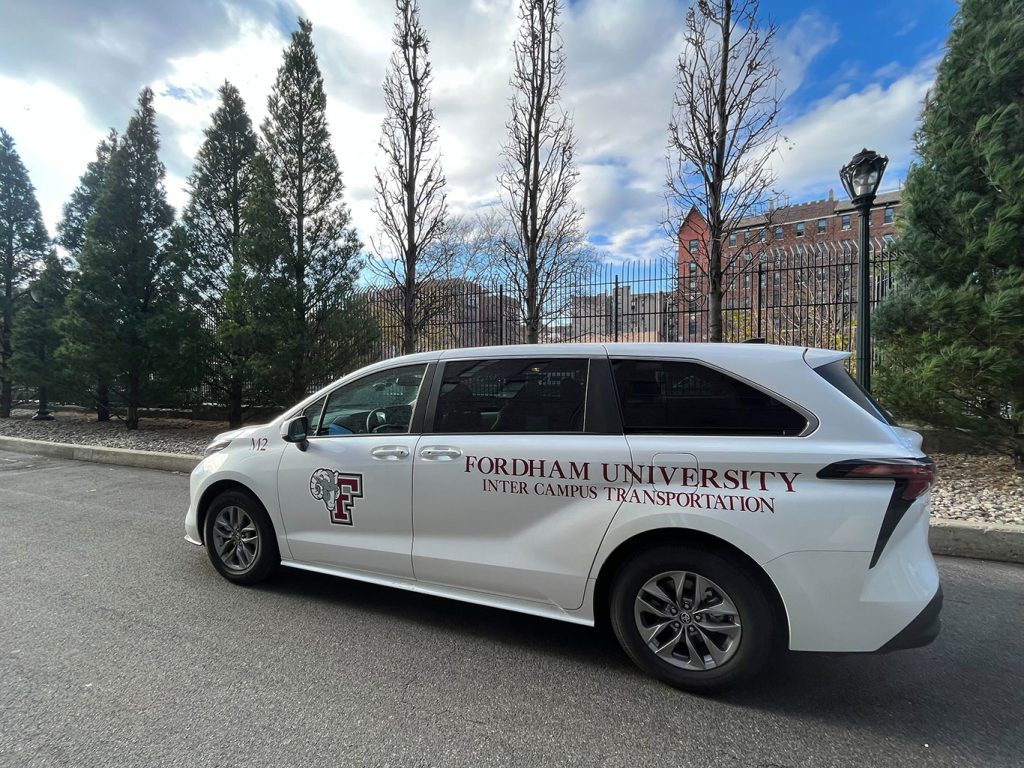
Dining
Micro Farms
This fall, Aramark installed vertical hydroponic units called Babylon Micro Farms at dining halls on the Lincoln Center and Rose Hill campuses. They grow fresh greens and herbs in a water-based solution (instead of soil, which requires frequent watering.) The greens are harvested for use in dining hall dishes and special student events.
Compared to traditional methods, each micro farm uses 96% less water, zero pesticides, 65% less fertilizer, and zero miles to transport. As a result, between January and June 2023, using them allowed Fordham to save 19,247 gallons of water, prevent 2.5 pounds of nitrogen from entering waterways, and reduce 32 pounds of food waste.
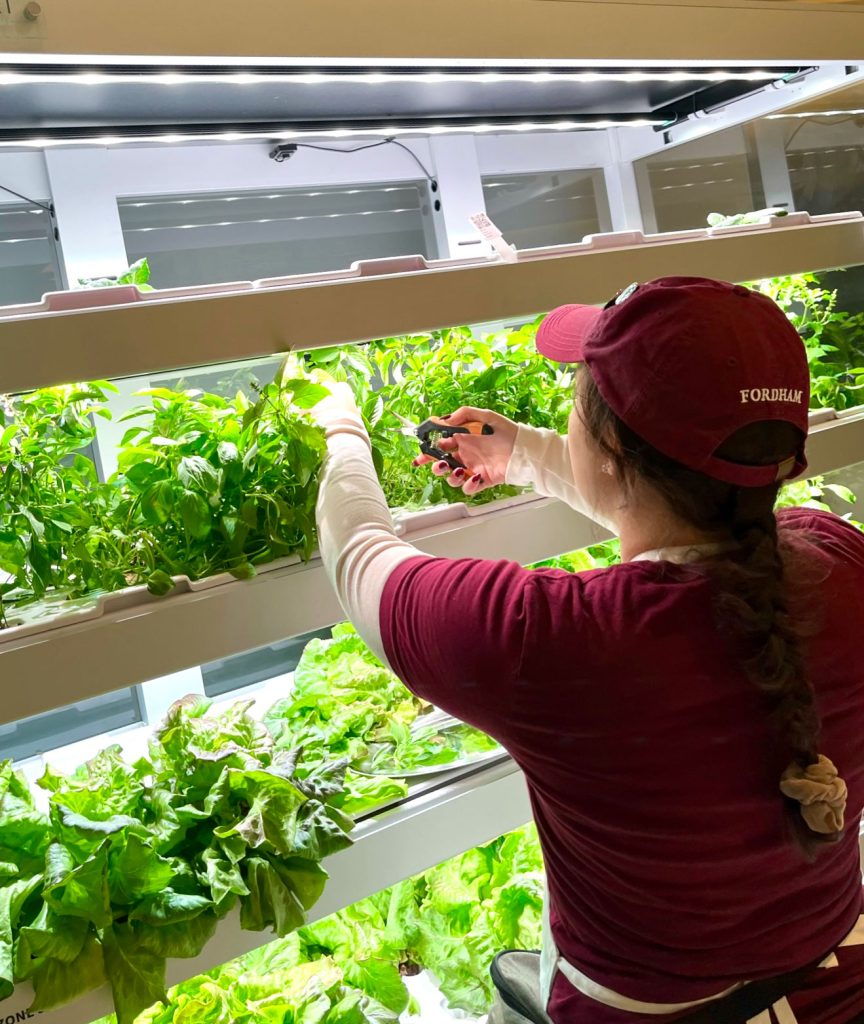
Academics
In the Classroom
Six undergraduate community-engaged learning classes offered in the Fall 2023 semester featured elements promoting sustainability: Anthropology of Food (Anthropology), Economics and Ecology of Food Systems (Economics), Thinking Visually (Visual Arts), Human Physiology (Biology), Consumer Behavior (Gabelli School of Business), and Leadership Integrated Project (Gabelli School of Business). At Fordham Law School, environmental law courses offered this semester included Environmental Law and Energy Law.
Fordham Law students wrote blog posts for the school’s Environmental Law Review on the Flint and Jackson water crises, NYC Local Law 97, the environmental damage caused by the fashion industry, and cell-cultivated meats.
Reading Laudato Si’
The Curran Center for American Catholic Studies held three seminars on Zoom this semester dedicated to reading Pope Francis’ encyclical Laudato Si’ and the 2023 follow-up, Laudate Deum. Visit the center’s website for more information on future seminars.
A Systems Approach
This semester, the Social Innovation Collaboratory and Career Center hosted a collaborative workshop on systems thinking, focused mainly on sustainability. The workshops, which were open to all undergraduate students, allowed them to explore the practice and application of systems thinking, which is rooted in a holistic approach to society’s more complex issues. The process is attractive to companies since it’s rooted in the idea of looking at complex problems with a new perspective. Contact Sadibou Sylla at the Collaborary for information on future workshops.
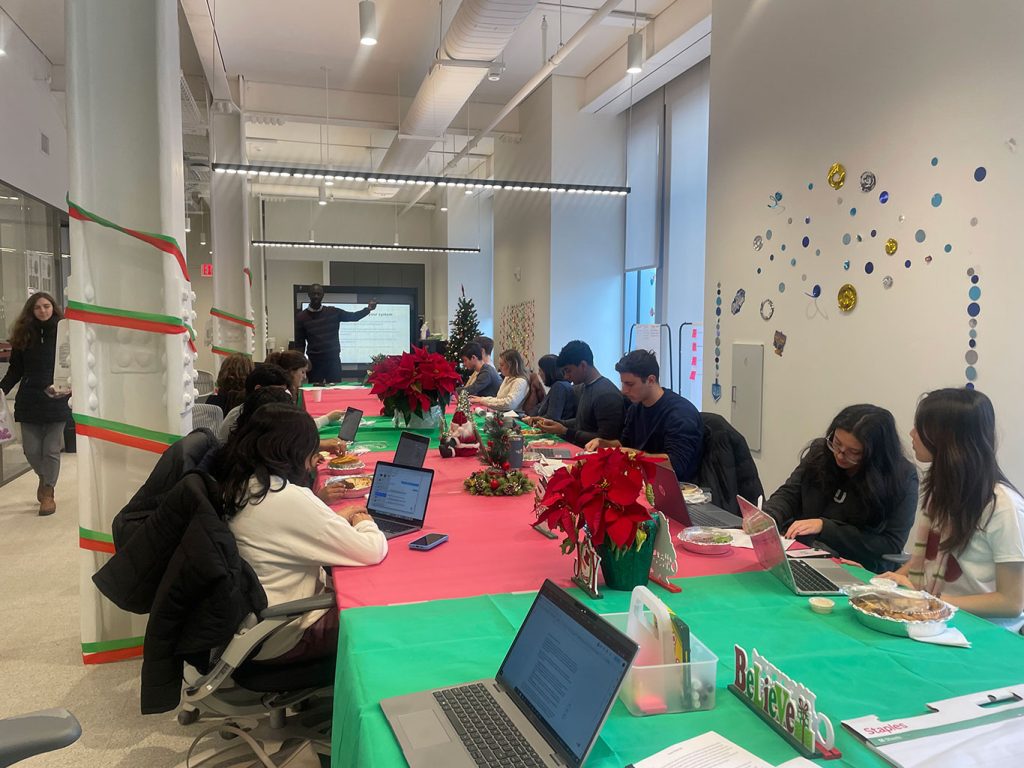
Students Take the Lead
Green Week: United Student Government sponsored Fordham College at Rose Hill’s Sustainability Week in November. It featured the Fordham Flea Pop-Up as well as a seminar on composting basics.
The Lincoln Center Environmental Club held a clean makeup tabling event on Nov. 30 to showcase the benefits of cruelty-free and clean makeup.
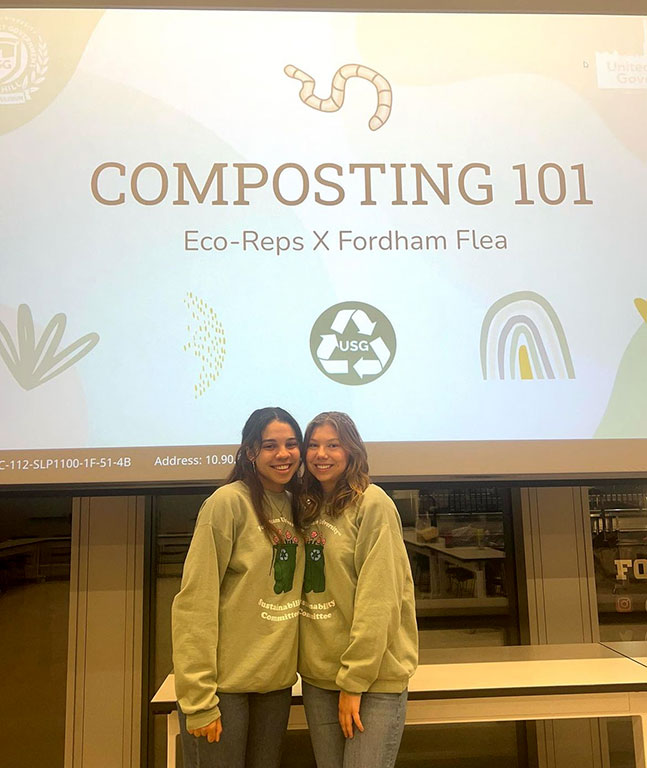
Community Engagement
As part of the Reimagine the Cross Bronx campaign, Fordham staff conducted weekend “walkshops” in the neighborhoods surrounding the highway. Funding came from a $25,000 grant from the New York City Department (DOT) that the Center for Community Engaged Learning received in October.
Fordham staff and students also held special Halloween and Thanksgiving-themed events at the Highbridge Farmers Market and community space, which was recently expanded thanks to an AARP grant.
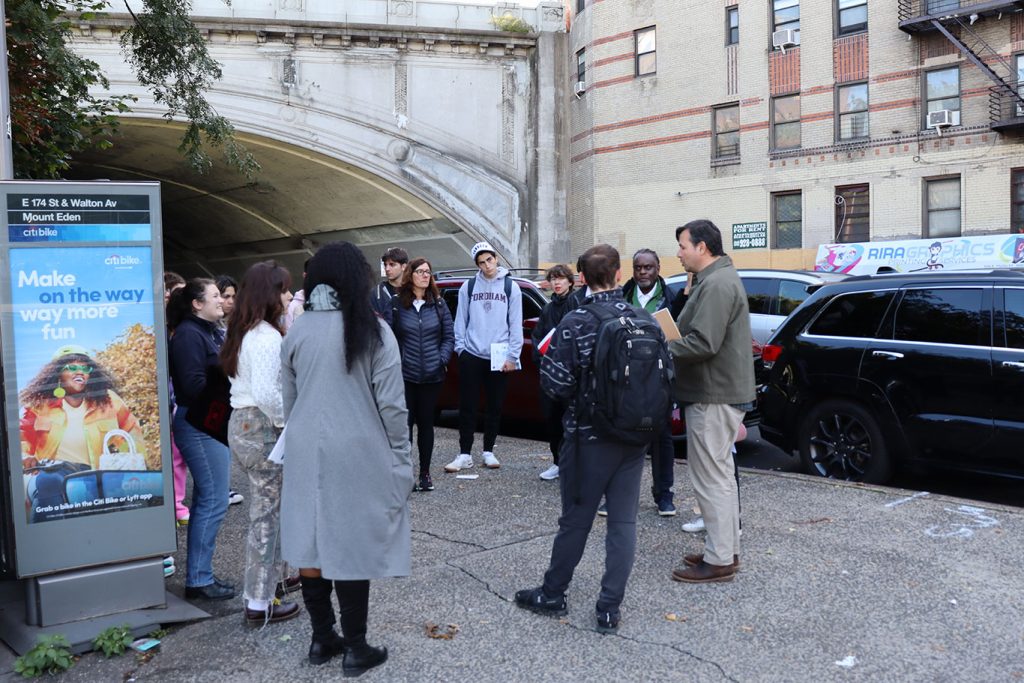
Faculty News
Marc Conte, Ph.D., professor of economics, published “Unequal Climate Impacts on Global Values of Natural Capital” in the journal Nature.
Stephen Holler, Ph.D., associate professor of physics, published “Education for Environmental Justice: The Fordham Regional Environmental Sensor for Healthy Air,” in the journal Social Sciences.
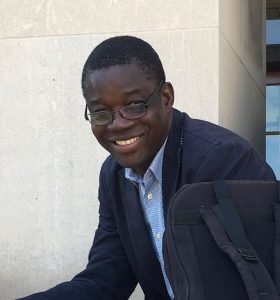
David Gibson, director of the Center for Religion and Culture (CRC), received $84,840 from the Porticus Foundation for the annual conference The Way Forward: Laudato Si’, Protecting Our Common Home, Building Our Common Church. The conference will take place in February at the University of San Diego.
Isaie Dougnon, Ph.D., associate professor of French and Francophone Studies and International Humanitarian Affairs, received $24,790 from the Wenner-Gren Foundation for research based on a local perspective on water and migration in West Africa.
Alumni
Giselle Schmitz, GSAS ’22, spent this fall working with the Coral Triangle Center in Bali, Indonesia—a nonprofit that connects governments, corporations, and local groups to help strengthen marine resources in the region.
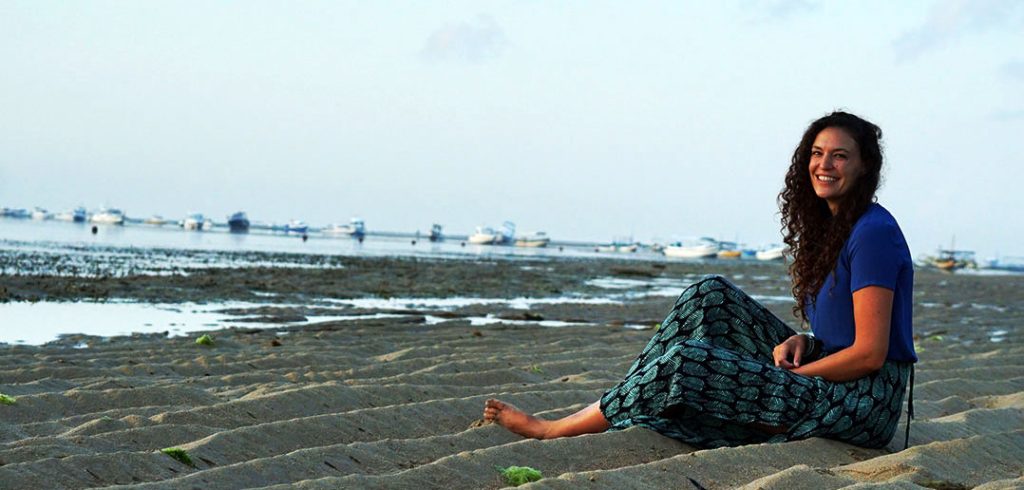
In Case You Missed It
It was a busy fall in terms of sustainability efforts! Here are some stories Fordham News covered that you may have missed: In October, the annual Fordham Women’s Summit focused on sustainability. In our theology department, a lecture for first-year students featuring Union Theological Seminary professor John J. Thatamanil connected religious supremacy to the destruction of the natural world. Four students have joined the Office of Facilities Management’s newly created internship program, while alumni are helping protect New York City’s birds and helping farmers adapt to climate change. The Gabelli School of Business hosted two Nobel Laureates at a conference on ESG. At the Law School, more than 20 students gathered in Central Park for a clean-up event for the annual Public Service Day, while alumna Melinda Baglio was honored for being a changemaker in the clean energy field.
Upcoming Events
Faculty Happy Hour: Sustainability and Environmental Justice
Open to all faculty interested in sharing ideas about sustainability.
Thursday, Jan. 18, 2024. RSVP: Julie Gafney, [email protected]
STEM Career Fair, Thursday, Feb. 15, Great Hall, Rose Hill Campus. Visit the Fordham Career Center next month for details.
Women of Color in STEM Career Panel, Wednesday, Feb. 28, Virtual. Visit the Fordham Career Center next month for details.
Social Impact and Non-Profit Micro-Fair, Thursday, March 14, 12th Floor Lounge, Lowenstein Center, Lincoln Center campus. Visit the Fordham Career Center next month for details.
Save the Date:
Climate Action Summit with President Tetlow: April 8, Rose Hill Campus
We’d Love to Hear From You!
Do you have a sustainability-related event, development, or news item you’d like to share? Contact Patrick Verel at [email protected].
]]>Shannon Marcoux discovered her passion for environmental justice in 2016, when she was teaching in Micronesia as a member of the Jesuit Volunteer Corps soon after graduating from Fordham College at Rose Hill.
“The school drew students from all over, including countries like the Marshall Islands, which are experiencing some of the worst impacts of climate change,” Marcoux says. “It’s such a pressing global issue that implicates so many different human rights—it’s migration and immigrant rights, it’s the right to food, the right to water. It affects the right to education.”
Marcoux says she “got really angry” when she saw how her students and their families were affected, not only by climate change but also by the legacy of colonialism in the Pacific Islands, and she wanted to channel that anger productively.
“I think for me the legal field is a very practical way to address some of these issues,” she says. “The legal field is a way to get concrete solutions where harm has occurred.”
Building on her Fordham degree in international political economy, she enrolled at Columbia Law School, where she published legal and policy research on both the human rights and environmental impacts of U.S. colonization and military presence in the Micronesian region. She focused on a treaty between the U.S. and the Marshall Islands, for example, and how it has created a “legal vacuum,” foreclosing many ways to address environmental and human rights issues.
“You’ve got [industrial chemicals]leaking into the lagoon, making all the fish that people catch uneatable and things like that, and nobody is responsible,” says Marcoux, who is currently a Bertha Justice Legal Fellow at EarthRights International, a global nonprofit headquartered in Washington, D.C. “I hope to continue writing about those issues to raise awareness and offer some legal analysis.”
Finding Her Vocation
Marcoux says her Fordham education, including participation in the Center for Community Engaged Learning’s Urban Plunge and Global Outreach programs, “made me realize that my vocation, what I wanted to do, was fight for justice.”
“You can talk about that in the classroom in an academic way, but it was through volunteering in the Bronx, it was through Global Outreach—those concrete, hands-on experiences made me realize I want to do this kind of work for the rest of my life,” she says. “This is what I’m passionate about. This is what gets me fired up.”
Read more “20 in Their 20s” profiles.
]]>By hosting events with partner organizations and adding opportunities to reflect and connect, the Office of Mission Integration and Ministry is working to help students, faculty, and staff find community on and off campus. The office’s expanding programs draw people who come from many faith backgrounds as well as those who come to their values from outside of religious faith.
“We do these events not only to amplify the mission but to also get different people across the University together—faculty, staff, students, alumni. We hope that it’s a very intergenerational thing,” said Robert Parmach, director of Ignatian mission and ministry at Fordham.
All of these programs are rooted in a tradition of balancing reflection and action developed by St. Ignatius Loyola, the 16th-century founder of the Society of Jesus, Parmach said. For example, on Nov. 16, about a dozen students and a few staff members gathered for a clothing sorting activity held at Xavier Mission, a Manhattan organization that provides services for those in need across New York City.
“We partnered with Xavier because there’s a real need for clothing for infants and toddlers, refugees, immigrants, and those who are experiencing homelessness right now,” Parmach said.
For Devany Kurtti, a sophomore at Fordham College at Lincoln Center, working with Xavier Mission was a chance to help members of the New York City community.
“It’s getting colder and so many people don’t have access to shelters,” Kurtti said. “I’ve always watched my parents and church help serve others. I know if I was having difficulties and didn’t have the resources I do, I would want someone to help.”
The event brought together a wide range of community members, including undergraduate and graduate students, and even alumni like Roxanne De La Torre, FCRH ’09, GRE ’11, who is the director of outreach at Xavier Mission.
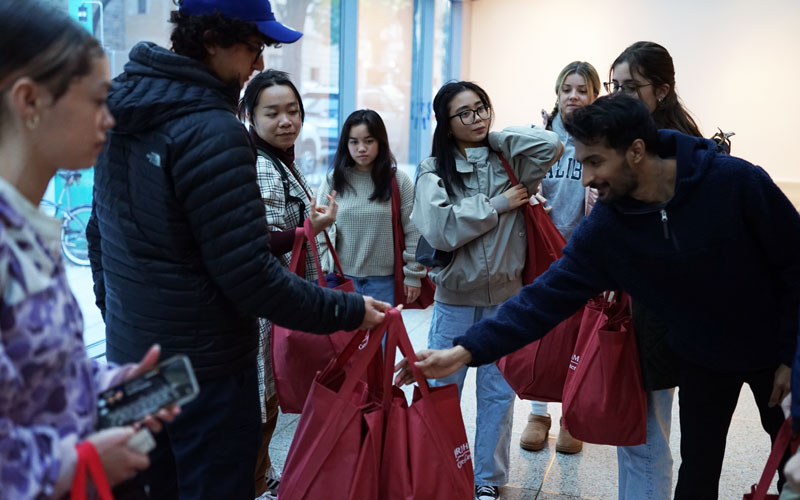
More Creative and Expansive Offerings
Parmach said that Fordham has also expanded its retreat options to help more members of the community take time for reflection, especially if they can’t go away for a more “traditional” multi-day retreat.
“We’re having one-hour retreats for busy people, and we’re getting really good turnouts there,” he said.
One recent retreat was a “paint and reflect,” where more than 30 students came to have pizza, talk, and create paintings. In addition, Parmach noted that they’re also doing “10-second reflections” around campus to connect with students quickly and increase the office’s visibility.
“The student that’s running to class, they come, they have a quick cup of coffee or hot chocolate or candy. They have a reflection prompt that they contribute to [by writing] on a poster,” he said. “And we’ve [reached] hundreds of students at these things.”
Erin Hoffman, director of campus ministry for Lincoln Center, said that the office is also planning to add to its interfaith programming, which includes an annual interfaith prayer ceremony and picnic, and Faith Fest, a new event last year.
“Fordham’s a place where faith matters, and we want students of all backgrounds to have opportunities to grow in their faith and form community with others while they’re here,” she said.
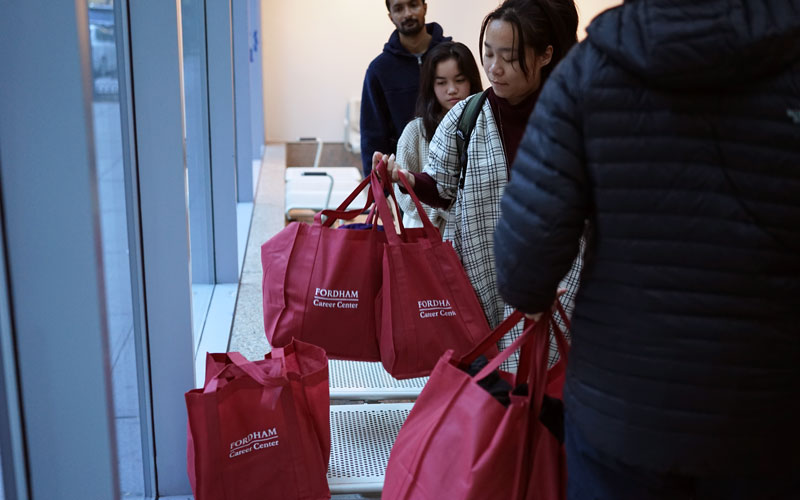
Additional reporting by Franco Giacomarra.
]]>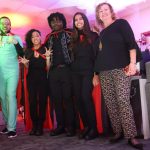
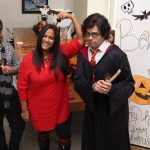
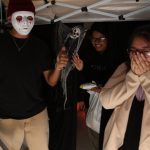
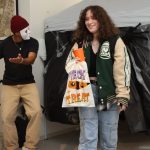
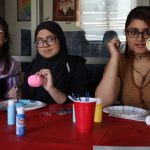
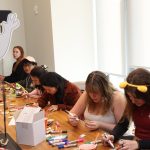
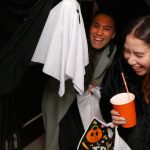
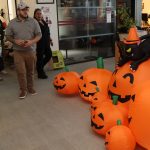
It was a new ambience for the Joseph M. McShane, S.J. Campus Center: eerie music, wolf howls, ghoulish costumes, giant cobwebs, a hallway-size haunted house, laughter mixed with the occasional frightful yelp.
The one flaw in the spookiness? All that natural light flooding in through the huge windows. “The sun is always shining in, it’s beautiful,” said Gabriel Chavarria, a Fordham College at Rose Hill senior passing through the Career Center and Campus Ministry areas.
The Haunted Open House marked a new effort to help fully integrate the McShane Center into University life by enticing students to wander the full length of the second floor, discovering the cavernous hallways and hangout areas along the way—as well as all the offices there to serve them.
The second floor’s Halloween-season transformation highlighted a much larger, permanent transformation of student life brought about by the campus center’s construction, a pillar of the University’s $350 million fundraising campaign, Cura Personalis | For Every Fordham Student.
Enhancing the Entire Student Experience
Construction on the campus center has continued since it opened to students last year. Amid the second-floor Halloween hijinks on Oct. 17, crews were working on the first-floor Marketplace renovation that will produce a vastly better dining experience in another nine months or so.
Unfinished as it is, the McShane Center already feels like students’ home. “This is such a huge resource, and I think it’s a real asset to the University,” said Isabella Guariniello, a junior at Fordham College at Rose Hill who found the haunted house to be “a really cool way to interact with the students and the faculty here.”
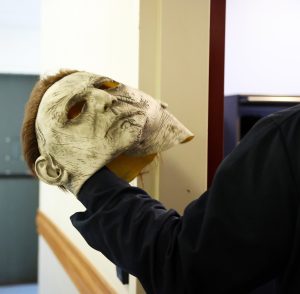
Commuter student Ryan Nole, a Gabelli School of Business junior, appreciates being able to hang out in the campus center between classes. He’s noticed that it’s brought new visibility to student clubs and organizations and provides a kind of social lubricant—“I know if I want to see someone, they’ll probably be here,” he said while checking out the open house. “It definitely fulfills its role as a community space.”
In fact, with so many students gravitating toward the new student lounge and communal spaces on the first floor, “we wanted another way for students to kind of say, ‘Hey, there’s more parts to the building, there’s a whole bunch of stuff up here,’” said Juan Carlos Matos, assistant vice president for student affairs for diversity and inclusion—dressed up for the occasion as “Dr. Acula.”
Students partook of Halloween candy—including the allergy-free kind—and activities like pumpkin painting. All of the second-floor offices got into the act, including Student Services, the Office for Student Involvement, and the Office of Multicultural Affairs.
‘Cathedral-Like’ Light
To be sure, the new campus center has already been boosting the work of second-floor offices including the Career Center, which gained a new suite equipped with 10 interview rooms, event space, and other amenities, including new capabilities to promote career-related events.
The new suite “has truly elevated our office University-wide,” said Annette McLaughlin, director of the Career Center. The 840 career counseling appointments held from July through September represent a 24 percent increase over the same period last year, she noted.
Campus Ministry and the Center for Community Engaged Learning, or CCEL, now share a roomy, inviting suite with floor-to-ceiling windows providing “cathedral-like” light, in the words of Campus Ministry administrator Carol Gibney. It offers plenty of room for students to study or hang out and unwind, making it more likely that they’ll learn about something they want to get involved in, said Amanda Caputo, FCRH ’23, a program manager with Global Outreach. “Students [have]made this their home, in a way,” she said.
By providing generous, dedicated space for CCEL’s meetings with its New York City partner organizations, the facility “demonstrates the University’s commitment to community engagement and experiential learning,” said the center’s executive director, Julie Gafney, Ph.D.
“It helps to show that this is what we mean when we say we’re a Catholic and Jesuit institution,” she said. “We mean that we create spaces that put our mission work first.”
Learn more about the McShane Campus Center renewal and opportunities to give in support of it.
]]>The highway, which was constructed in the 1950s and ’60s, has long been blamed for a host of poor health outcomes in the Bronx. In December 2022, New York City Mayor Eric Adams announced the creation of a study to reimagine the highway, including options such as rerouting it through a tunnel or building parks atop the sunken sections.
That study is being funded by a $2 million U.S. Department of Transportation grant created by the Infrastructure Investment and Jobs Act passed by Congress in 2021.
Giving Voice to Community Members
The Center for Community Engaged Learning was one of 10 community partners chosen to assist the DOT in gathering input from residents who live near the expressway. The center will use the funds to organize listening sessions and collaborate with other community groups, including Gambian Youth Organization, Casa Yurumein, and Bronx Health Link. The groups will work together to organize events and canvas the neighborhoods surrounding the highway.
Aiming to Reunite Neighborhoods
Julie Gafney, director of the Center for Community Engaged Learning, said she hopes the efforts will help reunify neighborhoods that were destroyed when homes of approximately 40,000 residents were demolished to make room for the highway.
“One of the big issues with the Cross Bronx Expressway and other major roadways in the Bronx is it cut people off from access to services, to fresh fruits and vegetables, to public transportation,” she said.
“So we want to make sure that whatever solution we’re looking at is going to unite communities, provide resources to them, and doesn’t inadvertently replicate some of these errors from the past.”
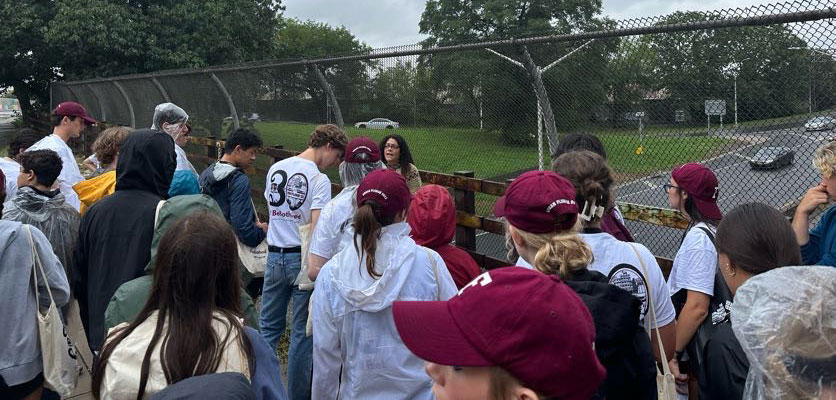
Opportunities for Students
The Cross Bronx Expressway has been a major focus of the center’s recent efforts in the Bronx. Last month, 350 students who participated in Fordham’s annual Urban Plunge toured sections of the highway to learn about its impact. Gafney said members of the Fordham community are continuing to enroll in these “walkshops.” She envisions multiple opportunities for students to get involved in areas such as design, visual arts, architecture, and smart city planning.
“I would love to see as many members of the Fordham community working as possible with us to facilitate those conversations,” she said.
“We’ll be doing everything from canvassing and door-knocking to holding small conversations over coffee with groups of neighbors to hear about how the Cross Bronx is currently affecting them and their communities and what they would like to see. The best ideas, I’m sure, are going to come from the folks who are most impacted by the issue.”
]]>